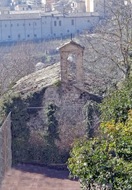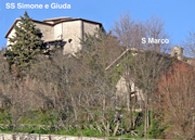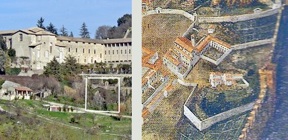


The Abbazia di San Marco is first documented in relation to Abbot Eleutherius in the Dialogues of Pope Gregory I (ca. 593). There is archeological evidence of a church and cemetery here in the 6th century:
-
✴A funerary inscription [CIL XI, 7919] found near this small church related to Annidius Numeianus, who died in 543 AD at the age of 74. [Where is it ??]
-
✴A mosaic (6th century) of red, white and black tesserae, which was discovered in what seems to have been the crypt of the old church in the 1920s, is now in Room 4 of the Museo del Ducato di Spoleto.
Abbot Eleutherius
A number of entries in the Dialogues that illuminate life at San Marco under Abbot Eleutherius, “the father of the Abbey of the Evangelist St Mark, which is in the suburbs of the city of Spoleto”:
-
✴The monks told Gregory I that “by his tears [Eleutherius] raised up one that was dead” (Book III, Chapter 33).
-
✴Eleutherius told Gregory I how he had come across a young boy who lived in a nunnery and was possessed by devils, had taken him back to San Marco, and with the help of the other monks, had cured him (Book III, Chapter 33).
-
✴He gave Gregory I information about St Isaac, a monk on Monteluco, with whom he was familiarly acquainted (Book III, Chapter 14). He encouraged a young woman to form a nunnery in Spoleto, despite the opposition of her family. Specifically, he told Gregory I how, in Spoleto, “a certain worshipful man's daughter, for years marriageable” defied her father and “took upon her the habit of holy conversation”. Her father disinherited her, leaving her only “six little pieces of ground”. She attracted other followers from the young women of the city who decided “to dedicate their virginity to almighty God, and to serve him”. Abbot Eleutherius, who visited her to give her encouragement, saw her drive an evil spirit out of a countryman who had come to bring her presents (Book III, Chapter 21).
-
✴He told Gregory I about his brother, John, who lived with him in his abbey at Spoleto. John prophesied his own death 14 days before it happened. When he duly approached death and was taking the Last Rites, he suddenly called out: "Come away, Ursus". This meant nothing to the monks until, four days later, one of them travelled to another monastery some distance away. There he found the monks grieving for Ursus, one of their number, who had died at the “very instant” that John had died (Book IV, Chapter 35).
The Dialogues also reveal that Eleutherius later moved to the monastery of Gregory I in Rome. While there, he cured Gregory I of an illness that had prevented him from fasting at Easter. This seems to have occurred in the period 574-9, when Gregory I was still living in the monastery. Two other facts seem to throw light on the circumstances in which the monks left Spoleto:
-
✴Pope Benedict I (575-9) gave land in Minturno, Lazio to the abbey (see below).
-
✴The Lombard general Faroald invaded the city in ca. 576, as set out in the page on the Lombard Duchy of Spoleto).
It seems likely that the donation was made before the invasion, and that the invasion then prompted the monks to leave for Rome. At the time that Gregory I wrote his account (593), Eleutherius had died there.
Abbot Stephen
In a letter dated 599, Pope Gregory I wrote to his agent telling him to deal with a request from “Stephanus”, the Abbot of San Marco for the restitution of property that Pope Benedict I had given to the abbey (see above). The letter defines the abbey as “iuxta muros Spolitinae civitatis” (beside the city walls) and instructs the agent to effect the restitution “ (without any hindrance or altercation). This suggests that the abbey was getting back to normal after the peace of 598.
Later Church


In 820, the Emperor Louis the Pious confirmed an agreement between the Abbazia di Farfa and Bishop Sigualdus of Spoleto that related to the ownership of San Marco.
The complex, which was outside the Roman walls, seems to have been destroyed in Saracen raids in the 10th century. It subsequently passed to the Abbazia di Farfa and was rebuilt.
-
✴In 956, Abbot Hildebrand of Farfa disposed of an adjoining parcel of land that lay between the city wall and the property of "Sancta Maria Episcopii Spolitani". This record is important because:
-
•it suggests that San Marco was already a dependency of Farfa at this time; and
-
•it constitutes the first record of a church dedicated to the Virgin on the site of the present Duomo.
-
✴In 1252, the rector and the Abbot of Farfa gave further adjacent land to the Franciscans for the new church and convent of SS Simone e Giuda.
The church and surrounding buildings were subsequently abandoned.
In the illustration to the right above is a detail of a painting (ca. 1636) of Pope Leo III arriving at Spoleto (Pinacoteca). The Abbazia San Marco is shown between the inner and the outer circuit of walls, with the Convento di SS Simone e Giuda in the background.

